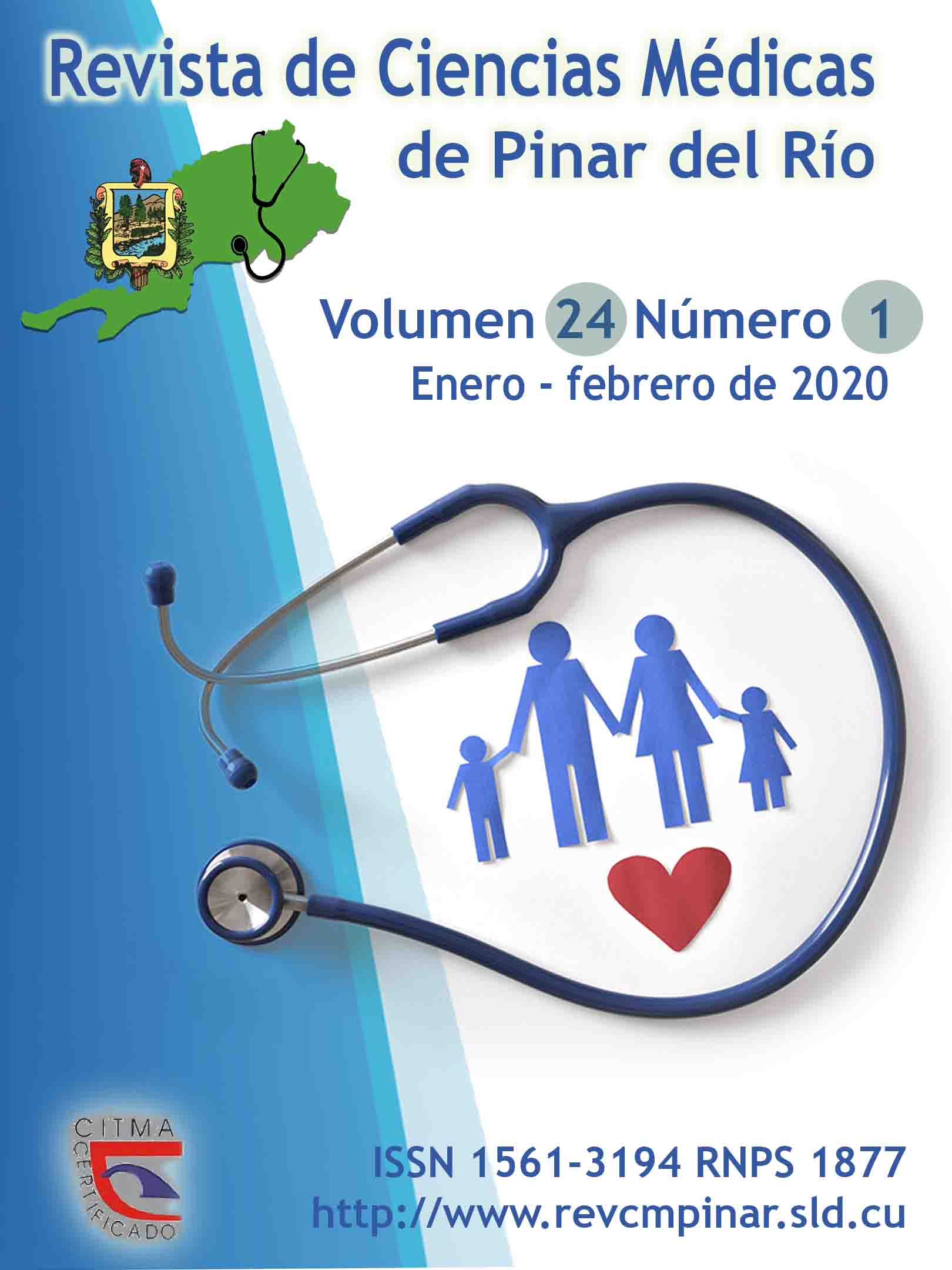Treatment with Klammt Elastic Open Activator in patients with Class III Syndrome
Keywords:
ORTHODONTIC APPLIANCES, FUNCTIONAL, MALOCCLUSION, ANGLE CLASS III, CEPHALOMETRYAbstract
Introduction: in recent years a range of functional appliances has been successfully used for Class III. One of them is Klammt Open Elastic Activator, which has a simple design, unlike other devices that are used to correct this type of malocclusion.
Objective: to evaluate the effectiveness of Klammt elastic open activator treatment in Class III Syndrome.
Methods: an analytical, longitudinal and prospective study was carried out at José Martí Orthodontic Service Clinic in Consolación del Sur, Pinar del Río. The target group consisted of 15 patients with Class III syndrome, the sample was comprised of 10 patients who met the inclusion criteria. Clinical diagnosis and cephalometric studies were performed on each patient and after orthodontic treatment.
Results: after treatment, there were positive changes in the overpass, molar relation and incisor protrusion. The most notable cephalometric-skeletal results were: an increase in the ANB angle due to a decrease in the SNB, as well as a decrease in mandibular length. These results were corroborated by applying the Wilcoxon nonparametric test for a significance level of 0.05.
Conclusions: Klammt Open Elastic Activator is an effective method in patients with Class III Syndrome, especially when it is applied in early ages.
Downloads
References
1. Rodríguez Carracedo EM, Romero Junquera CR, Portelles Massó A, Amador Rodríguez As. Corrección ortodóncica quirúrgica del prognatismo mandibular. CCM [Internet]. 2013 [Citado 12/12/2018]; 17(Suppl 1): [aprox. 6p.]. Disponible en: http://scielo.sld.cu/scielo.php?script=sci_arttext&pid=S1560-43812013000500008&lng=es
2. Donjuán Villanueva JJ, Vásquez Estrada HA, Hernández Carvallo JR, Nachón García MG. Tratamiento ortodóncico-quirúrgico en paciente con maloclusión clase II. Reporte de caso. Revista Mexicana de Ortodoncia [Internet]. 2016 [Citado 21/03/2017]; 4(2): [aprox. 14p.]. Disponible en: http://www.sciencedirect.com/science/article/pii/S2395921516301611
3. Durán Vázquez WE, González Espangler L, Ramírez Quevedo Y. Uso del modelador elástico de Bimler en el tratamiento de pacientes con pseudomesioclusión. Medisan [Internet]. 2016 [Citado 15/10/2018]; 20(7): [aprox. 10p.]. Disponible en: http://scielo.sld.cu/scielo.php?script=sci_arttext&pid=S1029-30192016000700007
4. Alzate J, Álvarez E, Botero P. Tratamiento Temprano de la Maloclusión Clase III con aparatología Ortopédica: Reporte de caso con 7 años de control. Revista de Odontopediatría Latinoamericana [Internet]. 2014 [Citado 21/03/2018]; 4(1): [aprox. 12p.]. Disponible en: https://www.revistaodontopediatria.org/ediciones/2014/1/art-9/
5. Condezo M. Tratamiento Craneofacial Miofuncional Postural Clase II con Activador Elástico Klammt II. Dental Tribune Hispanic & Latin America [Internet]. Universidad Garcilaso de la Vega y el Colegio Odontológico del Perú; 2015 [citado 22/04/2016]: [aprox. 20p]. Disponible en: https://la.dental-tribune.com/clinical/tratamiento-craneofacial-miofuncional-postural-clase-ii-con-activador-elastico-klammt-ii/
6. Instituto Maxilofacial. ¿Qué es y cómo se trata el Prognatismo Mandibular o Clase 3? [Internet]. España; 2018 [Citado: 12/12/2018]: [aprox. 6p.]. Disponible en: https://www.institutomaxilofacial.com/es/tratamiento/cirugia-ortognatica-prognatismo-mandibular-o-clase-3/
7. González Valdés D, Alemán Sánchez PC, Delgado Díaz Y. Prevención y tratamiento precoz de la oclusión invertida en la Atención Primaria de Salud. Rev Haban Cienc Méd [Internet]. 2015 [Citado 24/07/2016]; 14(6): [aprox. 11p.]. Disponible en: http://scielo.sld.cu/scielo.php?pid=S1729-519X2015000600009&script=sci_arttext&tlng=pt
8. MedlinePlus. Prognatismo. [Internet]. EEUU: Enciclopedia médica; 2018 [Citado 12/12/2018]: [aprox. 8p.]. Disponible en: https://medlineplus.gov/spanish/ency/article/003026.htm
9. Otaño Lugo R. Aparatos Funcionales. En: Otaño Lugo R. Manual clínico de Ortodoncia. Cap. 10. La Habana: Editorial Ciencias Médicas; 2008. p. 165-169.
10. Hernández Rodríguez JM, Machado Martinez M, Véliz Concepción OL, Riveras Truyt R, Ortega Romero L. Efecto del activador abierto elástico de Klammt III modificado en pacientes con fisuras labiopalatinas. Medicentro Electrónica [Internet]. 2015 [citado 17/10/2017]; 19(3): [aprox. 8p.]. Disponible en: http://scielo.sld.cu/scielo.php?script=sci_arttext&pid=S1029-30432015000300003
11. Martínez Rodríguez M, Martínez Vergara Y, Rezk Díaz A, Torres Lima M, Bioti Torres AM. Efectividad del retropropulsor-estimulador 2 en el tratamiento del síndrome clase III de Moyers. Revista de Ciencias Médicas de Pinar del Río [Internet]. 2017 [citado 21/03/2018]; 21(5): [aprox. 6p.]. Disponible en: http://scielo.sld.cu/scielo.php?script=sci_arttext&pid=S1561-31942017000500007&lng=es
12.Rezk Díaz A, Martínez Vergara Y, Martínez Rodríguez M, Bioti Torres A.M. Maloclusión clase III tratada con retropropulsor-estimulador 2: un caso. Revista de Ciencias Médicas de Pinar del Río [Internet]. 2016 [citado 21/03/2018]; 20(5): [aprox. 6p.]. Disponible en: http://www.revcmpinar.sld.cu/index.php/publicaciones/rt/printerFriendly/2592/html
13. Alfonso Valdés H, Morejón Álvarez FC, García Díaz C, Corbo Rodríguez MT, Díaz Barrio H. El retropropulsor y estimulador de Buño: su uso en los prognatismos mandibulares, cambios cefalométricos. Rev. Ciencias Médicas [Internet]. 2014 [citado 13/03/2015 mar 13]; 18(3): [aprox.14p.]. Disponible en: http://scielo.sld.cu/scielo.php?script=sci_arttext&pid=S1561-31942014000300011
14. Herrera Serrano SP, Gurrola Martínez B, Casasa Araujo A. Tratamiento de mordida cruzada, paciente clase III, sin extracciones. Reporte de caso. Revista Latinoamericana de Ortodoncia y Odontopediatría [Internet]. 2016 [citado 13/12/2018]; s/v(24): [aprox. 23p.]. Disponible en: https://www.ortodoncia.ws/publicaciones/2016/art-24/
Downloads
Published
How to Cite
Issue
Section
License
Authors who have publications with this journal agree to the following terms: Authors will retain their copyrights and grant the journal the right of first publication of their work, which will be publication of their work, which will be simultaneously subject to the Creative Commons Attribution License (CC-BY-NC 4.0) that allows third parties to share the work as long as its author and first publication in this journal are indicated.
Authors may adopt other non-exclusive license agreements for distribution of the published version of the work (e.g.: deposit it in an institutional telematic archive or publish it in a volume). Likewise, and according to the recommendations of the Medical Sciences Editorial (ECIMED), authors must declare in each article their contribution according to the CRediT taxonomy (contributor roles). This taxonomy includes 14 roles, which can be used to represent the tasks typically performed by contributors in scientific academic production. It should be consulted in monograph) whenever initial publication in this journal is indicated. Authors are allowed and encouraged to disseminate their work through the Internet (e.g., in institutional telematic archives or on their web page) before and during the submission process, which may produce interesting exchanges and increase citations of the published work. (See The effect of open access). https://casrai.org/credit/



